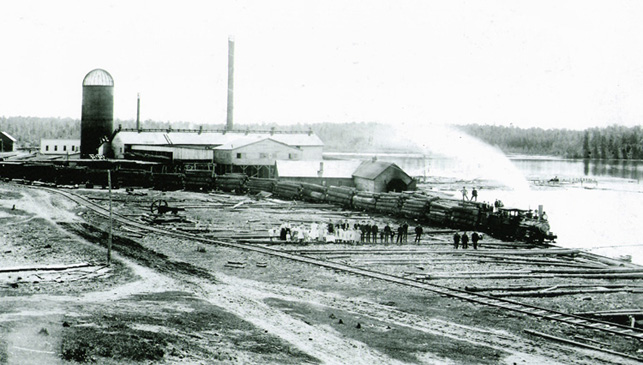The History of
Bundy, Wisconsin
|
Click here for larger photo.
|
 |
"Bundy" or "Jeffris"
, as it used to be
called, is located in the town of Harrison near Pine Lake on Highway 17. It
was built on a spur of the Chicago & North Western railroad and was named by
D. K. Jeffris, in honor of his brother, James K.
Jeffris, according to some sources. D.K Jeffris
built a sawmill there in the winter of 1891 and operated the lumber mill and
post office on
Pine Lake. The mill burned down Feb. 14, 1895, the owner suffering a
loss of about $20,000. Jeffris rebuilt the mill, however, it suffered a
second mill burning on October 28, 1897. The mill was
rebuilt
again in Sept 1898. After Mr. Jeffris finished his
operations there, he sold out to James Worden, (1864 - 1930) owner of the Worden
Lumber Co of Grand Rapids, Michigan in January, 1903, and the village
post office name was changed to Bundy. The Worden Lumber Company, or Bundy
Lumber Company as it was called, ran and maintained operations at the mill
in Jeffris for many
years. On December 1, 1906, Worden Lumber Company changed its name to The
Bundy Lumber Company. Company officers were Clay C. Hollister and
McGeorge
Bundy (1855 - 1911). In April of 1913, the Bundy Lumber Company (formerly Worden Lumber)
sold the mill and property to Ole Larson,
and the Larson Lumber Company was formed. Officers were: Ole
Larson, Gust Nelson, Gust Person and Albert Larson. On April
26, 1915, the village name was again officially changed from Bundy to Jeffris. Mr. Larson
kept the mill in operation for many years, but the supply of timber was
rapidly depleting. In
June, 1975, the village of Jeffris was officially
changed to Bundy. By then, the echoes of the mill and the sounds of giant,
old growth
timber falling were long silent, and the loggers , along with their
families, moved to follow the lumber mills farther north. The school house
on the hill overlooking Pine Lake was moved to Harrison and added to
the Harrison school. Most of the houses on Red Row were dismantled for the
lumber.
The Bundy Lumber Company was a historical mill in Wisconsin logging history.
At the time, it was one of Wisconsin's largest lumber mills, and many of the
local residents still have fond memories of the men who worked there.
|
|
Prior to Oneida
County's formation, Lincoln County stretched from just north of Wausau to
the Michigan line. During those early years, the county lines were disputed
many times, mostly by the citizens who preferred to go to one city over
another to transact any county business. "Jeffris" or "Bundy", as some prefer, was a town located south of Rhinelander on Highway
63, now Highway 17, along Pine Lake. It is believed to have been pushed back
and forth from Lincoln to Oneida County a few times, with some of the Bundy
residents living on the Oneida County side and some living on the Lincoln
County side. At times it was
a night stop over for visitors to Rhinelander, or a fresh horse for the mail
carrier. Squash Lake Road then went to Rhinelander. The town was composed of
a red row and green row, identified by
the colored tar paper; black tar paper did not stand the wind and rain as
well. The less fortunate lived in the green row. All these had a fine-stone
finish, congruent to the area resources. The railroad line went to Tomahawk
and back to Parrish Junction and Pelican Lake . D. K. Jeffris hired a man from
Illinois to be post master of Jeffris, Charles Fralick. Charles
Fralick, born in Michigan, had been raised in an orphanage and college
educated, after the death of his parents during a train wreck, when he was
just a boy. Fralick, his
British wife Maria (Brown), three daughters, Laura, Lottie, Nellie, and two
sons, Edward and Ned, made the long trip to Bundy.
|
|
Making a living
had been difficult in northern Illinois and Fralick saw this as his chance to make
his fortune in the great northern Wisconsin logging industry. The Fralicks
came by train and stayed with Keglers until a company house could be
assigned.
Besides being
postmaster, Charles Fralick was the Harrison town clerk and storekeeper for
several years. The mill men could charge at the company store until payday. It was
common in early mill days that the owner of the mill owned the whole town,
buildings and all, and at times even had their own money, to be used only in
that mill town. Fralick died in 1908, a decade after coming
to Bundy. He was buried in the Forest Home Cemetery, Rhinelander, in what is now
an unmarked grave. Laura married Len Daugherty, a break man on the logging
train. Nellie married George Kjell, moving back to Illinois, where she was born.
Edward married Mary Barker. Ned also married a local Bundy girl. Lottie married
a farmer, Philip Pond, in 1908, who lived just south of Parrish with his mother,
Mary Pond, and bachelor brothers, Charles and Willis. Willis drove the
stage from Dudley (north of Gleason) to Rhinelander for nine months of the
year. Lottie and Philip had 10 children, Cora was married twice, first to a Robison and next to a Wickham. Nellie was married to a Jewel.
Information taken from
"The Hodag Shopper" Section 2, page 4, Sept, 1984.
|
This website designed by Doug Hurlbutt in cooperation with
Gloria Rahlf. |
Photos provided by Gloria Rahlf and Bill Guolee.
Drop us an
Email for any comments.
|